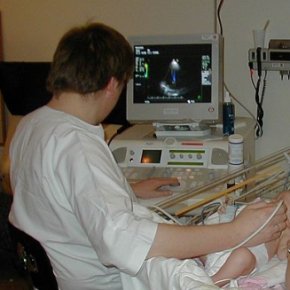| Ultrasound Technicians: A Quick Look |
| Median Salary |
$60,350 per annum |
| Entry-level education |
Associate’s degree |
| On-the-job training |
No |
| Primary employers |
Hospitals |
| Number of positions (U.S.) |
110,400 |
| Job Growth (2012-2022) |
39% (Very fast) |
| New positions (2012-2022) |
+42,700 |
Ultrasound technicians – also commonly known as diagnostic medical sonographers – use ultrasonic imaging equipment to examine internal organs that physicians can use to make a medical diagnosis. Read more.
The median annual salary of an ultrasound technician is $60,350 in the United States. Read more.
Ultrasound technicians must attain an associate’s or bachelor’s degree from an accredited sonography program. They may also be required to obtain personal certification and licensing. Click here to find out more about how to How to Begin a Professional Career as an Ultrasound Technician -Read more.
The job outlook for ultrasound technicians is excellent, with the U.S. Bureau of Labor Statistics projecting a growth rate of 39% from 2010-2020. Read more.
Ultrasound Technician Salary
The median ultrasound technician salary in the U.S. is $60,350 per annum, or $29.01 per hour. The top 10% ultrasound tech salary was $91,070 or higher, while the bottom 10% earned $44,990 or less. The majority of ultrasound technicians are employed full-time. Because diagnostic imaging is sometimes required in emergencies, ultrasound technicians employed at hospitals may be required to work overnight or on weekends. The average diagnostic medical sonographer salary is expected to rise over the next 10 years as demand in the profession is fuelled by an increasingly aging demographic.
How To Become An Ultrasound Technician
How do you become a diagnostic medical sonographer? Aspiring ultrasound technicians should pursue an associate’s or bachelor’s degree in an accredited diagnostic medical sonography program.
How Long Does It Take To Become An Ultrasound Technician
It takes between 2-4 years to become an ultrasound technician. Ultrasound programs in some jurisdictions require a 2 year degree in a health-related field – along with several pre-requisite courses such as medical terminology, anatomy/physiology, and patient care – before applicants are accepted into a 2 year sonographer program. In other cases, individuals may be accepted into an associate’s degree program with just a high school diploma or equivalent.
Educational Requirements
In order to become a diagnostic medical sonographer you generally need to obtain a minimum of a 2 year associate’s degree in the field. For those already possess a health-related degree and are working in healthcare jobs , 1 year certificate programs are available for those looking to transition into a career as an ultrasound tech. Some individuals also pursue a bachelor’s degree in the field. A certificate program, associate’s degree, or bachelor’s degree will provide students with the opportunity to practice the skills and gain the knowledge needed in order to apply diagnostic medical sonography techniques in real-world scenarios. For individuals who want to eventually move into management positions supervising other sonographers, a 4 years bachelor’s degree would be beneficial. The specific educational requirements required to become a diagnostic medical sonographer may vary state-by-state.
Certification
Requirements for ultrasound technician certification varies from state-to-state. Some states require ultrasound technicians be licensed, which usually involves graduating from an accredited sonographer program, and obtaining certification by passing an exam. Certification for ultrasound technicians is obtained through ARDMS. The base ARDM certification exam contains 110 multiple choice questions, as well as additional situational based questions that test the examinee’s ability to approach real world patient interactions. The exam is 2 hours in duration. In addition to the base ARDM exam, individuals pursuing certification must complete an exam in their chosen sub-specialty (e.g. abdomen, breast, fetal echocardiography). Specialty exams are 3 hours in duration and consist of 170 multiple choice questions.
Licensing
Not all states require licensing. Check with your local state board to determine if you need to be licensed in order to work as an ultrasound technician. When it licensing is required, licensees must generally have graduated from an accredited institution and passed the certification exam offered through ARDMS, though individual states may have additional requirements for licensure.
Ultrasound Technician Job Description
What does an ultrasound technician do? Ultrasound technicians use ultrasound equipment to assess patients and assist with medical diagnosis. The ultrasound equipment sends high-frequency waves into the body, which bounces back to create an image of the patient’s body, which can be shown on a screen. Physicians utilize these recorded images in order to assist with their medical diagnosis. Ultrasound technicians may specialize in specific parts of the body. Here are some examples of specialized ultrasound technicians/sonographers.
Abdominal Sonographers Breast Sonographers Musculoskeletal Sonographers Neurosonographers Obstetric and gynecologic sonographersJob Outlook
The job outlook for ultrasound technicians is excellent, with a projected national job growth of 39%, which is significantly faster than the national projected job growth rate of 11%. There were 110,400 diagnostic medical sonographers employed in the United States in 2012. This number is expected to rise by 42,700 by 2022. This growth is expected to be driven by an aging population which will require ultrasound technology in diagnosing medical conditions. The growth will also be driven by the increased use of ultrasound technology for diagnostic purposes, as it continues to replace more invasive techniques.

 What Does An Ultrasound Technician Do?
What Does An Ultrasound Technician Do?
Leave a Reply